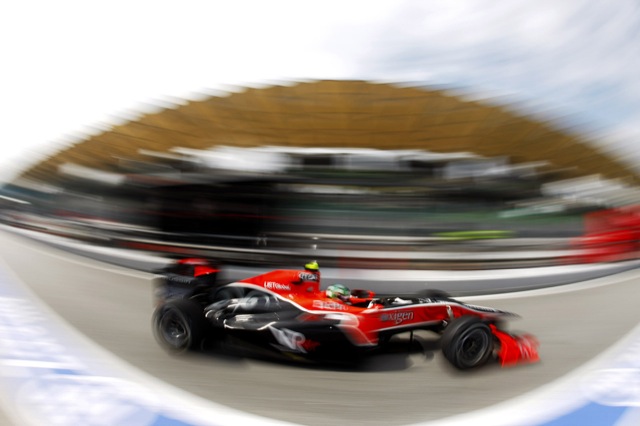 Traveling at close to 200mph, a racing driver has to absorb a lot of information in order to be as effective as possible. Looking through his visor, a typical pilot has to not only control the car through corners and over the undulations on the track surface, but also has to communicate with his team via the radio, adjust settings on the car via the steering wheel controls and concentrate on where the car is heading as well as being aware of what is around him, both in front and behind. So it comes as a bit of a surprise that what a racing driver actually sees is incredibly limited. Through the visor, the primary view is the steering wheel and a small amount of outside world just above that. Let’s wonder just how that looks, with a little help of real-world comparisons.
Traveling at close to 200mph, a racing driver has to absorb a lot of information in order to be as effective as possible. Looking through his visor, a typical pilot has to not only control the car through corners and over the undulations on the track surface, but also has to communicate with his team via the radio, adjust settings on the car via the steering wheel controls and concentrate on where the car is heading as well as being aware of what is around him, both in front and behind. So it comes as a bit of a surprise that what a racing driver actually sees is incredibly limited. Through the visor, the primary view is the steering wheel and a small amount of outside world just above that. Let’s wonder just how that looks, with a little help of real-world comparisons.
The visor is a small portal through which a driver looks. Peripheral vision is severely lacking and with head restraints, cockpit padding and the HANS device, movement is restricted considerably. Moving in a straight line is a challenge in itself, but sweeping through a corner, bouncing over kerbs and overtaking are different stories altogether.
Consider looking through your letter box. While looking straight ahead you can see plenty, knowing what is on your left and right is nigh-on impossible though, bearing in mind you cannot move your head. Now add a piece of plastic over the hole. While the visor isn’t too restrictive in normal conditions, it can be a nightmare when the weather turns against you. But before we get on to the added discomfort of rain, we need to factor in some more hindering variables.
Ahead of you, as you peer through your letter box, is a small steering wheel. When moving straight forwards, the wheel is horizontal and neatly aligned with the bridge of the monocoque. However, turn the wheel 90 degrees in either direction and all you can see is your hand and arm. The wheel turns around and depending on direction, all you get is a nice shot of your gloved hand clutching the controls.
And sitting just forwards of an engine that will produce 19,000rpm, vibrations need to be factored in. So, now you’re looking through your letter box, through a piece of plastic with your hand blocking your view. And your sitting on your washing machine while it goes through a spin cycle.
Let’s add in some temperature for good measure. Not only are you wearing a helmet, but also a balaclava, a racing suit, Nomex underwear and your in a very cramped and pressurised environment. The sweat pours down your face and gets in your eyes. I imagine the stinging sensation is not felt, but the blurred vision cannot be ignored.
Just because it’s hot though, does not mean it cannot rain. The added difficulty of wet weather really hampers driving, yet Formula One pilots seem to ignore this and continue pushing their cars to the absolute limit. This, I find, incredible considering the levels of concentration increase while the handling of the car becomes troublesome.
Rain is probably the worst of all hindrances to a driver vision. Imagine again, if you will, sitting on your washing machine and looking through your visored letter box with few references available as to where you are on the circuit. Now get someone to spray water over the visor. While traveling at speed, the water collects and runs left and right across the face, causing further blurred vision. You could attempt to clear the water by wiping your hand over the front of the helmet, but in all honesty, it is a futile attempt that will last only a second.
To make matters even worse, water can collect in between the tear-off strips applied to the visor. The tear-off strip is a thin piece of sticky-back plastic. If mud, oil or anything gets stuck to the outside of the visor, the tear-off strip can be removed giving the driver a better view. The strips are limited, so drivers have to be absolutely sure they want to remove one, but sometimes they simply have to. Because the strips are layered onto the visor, water can seep into them and globules of rain make it look like your looking through a glass of water.
I think it was Jean Alesi who once said, after being asked about his ability to drive fast in the wet, “What you can’t see can’t hurt you.”


















Add comment